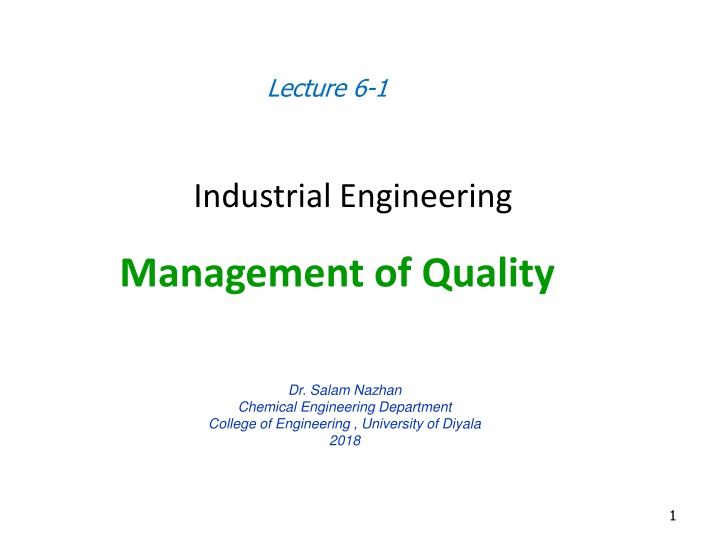
Quality Management in Industrial Engineering: Determinants, Consequences, Responsibility, and Costs
Explore the determinants of quality, consequences of poor quality, shared responsibility for quality across departments, and costs of Total Quality Management in industrial engineering. Learn about key factors impacting quality standards and how poor quality can affect businesses. Understand the crucial role each department plays in ensuring and maintaining quality in an organization.
Download Presentation

Please find below an Image/Link to download the presentation.
The content on the website is provided AS IS for your information and personal use only. It may not be sold, licensed, or shared on other websites without obtaining consent from the author. If you encounter any issues during the download, it is possible that the publisher has removed the file from their server.
You are allowed to download the files provided on this website for personal or commercial use, subject to the condition that they are used lawfully. All files are the property of their respective owners.
The content on the website is provided AS IS for your information and personal use only. It may not be sold, licensed, or shared on other websites without obtaining consent from the author.
E N D
Presentation Transcript
Lecture 6-1 Industrial Engineering Management of Quality Dr. Salam Nazhan Chemical Engineering Department College of Engineering , University of Diyala 2018 1
Outline Determinants of Quality The Consequences of Poor Quality Responsibility for Quality Costs of Total Quality Management Quality and Ethics ISO CERTIFICATIONS Reference: Production and Operations Management -University of Pakistan 2
Determinants of Quality The various Determinants associated with the quality concept in general and TQM philosophy in particular is: 1. Quality of design: Intension of designers to include or exclude features in a product or service 2. Quality of conformance: The degree to which goods or services conform to the intent of the designers 3. Quality of Ease of Use: Ease of use and instructions to use increase the chances but do not guarantee that a product will be used for intended purpose and function properly and safely. 4. Quality of Service after Delivery: The degree to which goods or services can be recalled and repaired, adjustment, replacement or buyback or reevaluation of service all come under this category. 3
The Consequences of Poor Quality The common consequences of Poor Quality are: 1. Loss of business: Loss in sales, revenues and customer base. 2. Liability: A poor quality product or service comes with the danger of the organization being taken to court by an unhappy or affected customer. 3. Productivity: Loss in productivity as more time is spend in rectifying the errors or short 4
Responsibility for Quality Quality Control Department cannot be held responsible for Quality alone. Quality is the responsibility of each and every individual working for the organization. If we look into any organization be it a manufacturing or service provider we can see the following departments working diligently for achievement of Quality. 1. Top management 2. Design Department 3. Procurement Department 4. Production/operations Department 5. Quality assurance Department 6. Packaging and shipping Department 7. Marketing and sales Department 8. Customer service Department 5
Costs of Total Quality Management There is a difference in opinion amongst experts when they analyze costs with respect to TQM. 1. Failure Costs - costs incurred by defective parts/products or faulty services. Failure costs are of two; a. Internal Failure Costs are the Costs incurred to fix problems that are detected before the product/service is delivered to the customer. b. External Failure Costs are all costs incurred to fix problems that are detected after the product/service is delivered to the customer. Of the two, Internal Failure Costs are less painful and can help an organization to register increase in revenue and not compromising its product or service in the eye of its customers as well as its competitors. 2. Appraisal Costs are the Costs of activities designed to ensure quality or uncover defects 3. Prevention Costs include all TQM training, TQM planning, customer assessment, process control, and quality improvement costs to prevent defects from occurring 6
Quality and Ethics Quality is closely associated with Ethics. A good service would always be able to fulfill customer needs if it is able to follow Ethics in its true spirit. A service or product that has been poorly designed carries liability. On the other hand if the organization has followed ethics to manufacture a product or service, it would be able to provide a quality product or service to its customer. 7
ISO CERTIFICATIONS International Organization for Standardization (ISO). A set of procedures and policies for international quality certification of suppliers Quality Certification ensures that the organization has been able to achieve TQM philosophy. The two popular certifications which are pursued by the organizations include ISO 14000 and ISO 9000. 1. ISO 14000: Is a set of international standards for assessing a company s environmental performance. 2. ISO 9000: Is a set of international standards on quality management and quality assurance, critical to international business. 8
References Introduction to Industrial Engineering, by Z. Max Shen Industrial Engineering, by N. J. Manck Industrial Management, by Shiv Jhalani Reference Books: 1. Management by Knootz. 2. Management by Griffin. 3. Management theory and Practices by JS Chandan.
